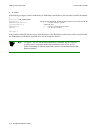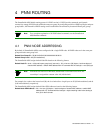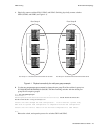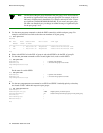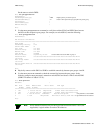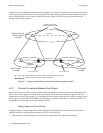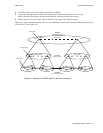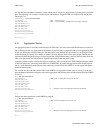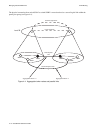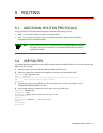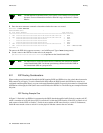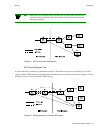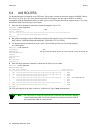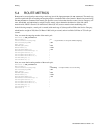4-8 SmartSwitch 6500 User Guide
Managing Parallel PNNI Links PNNI Routing
4.3 MANAGING PARALLEL PNNI LINKS
SmartSwitch 6500s can be connected by more than one physical link. PNNI treats these connections as parallel
physical links. By default, parallel links are considered to have equal capabilities with regard to call set ups.
For example, if a second link is added between switch A3 and switch B3 (from the example above), this parallel link
can be seen using the
show pnnilink command.
A3 # show pnnilink
Num(ALL) :
Num Port Node Remote Node Hello State Link Type
Number Index IP Addr
===========================================================================
1 7A1 1 206.61.237.20 2WayInside Lowest Level Horizontal Link
2 7A3 1 206.61.237.19 2WayInside Lowest Level Horizontal Link
3 7B1 1 206.61.237.23 CommonOut Outside and Uplink
4 7B2 1 206.61.237.23 CommonOut Outside and Uplink
< Second physical link to B3
5 -- 2 N/A 2WayInside Horizontal Link to/from LGN
6 -- 2 N/A 2WayInside Horizontal Link to/from LGN
< Second logical link to B3
A3 #
You can adjust the advertised capabilities of each link (on a per-port, per-service class basis) by changing the link’s
administrative weights. Use the
show pnniinterface command to view the current administrative weights. For
example:
Smart6500_1 # show pnniinterface
PortNumber(ALL) :
Port Admin Wt Admin Wt Admin Wt Admin Wt Admin Wt Aggregation
Number CBR RTVBR NRTVBR ABR UBR Token
================================================================================
CPU 5040 5040 5040 5040 5040 0
CPU.1 5040 5040 5040 5040 5040 0
7A1 5040 5040 5040 5040 5040 0
7A2 5040 5040 5040 5040 5040 0
7A3 5040 5040 5040 5040 5040 0
7A4 5040 5040 5040 5040 5040 0
7B1 5040 5040 5040 5040 5040 1
7B2 5040 5040 5040 5040 5040 0
7B3 5040 5040 5040 5040 5040 0
Smart6500_1 #
A link’s administrative weight defines its desirability to the PNNI routing service when setting up a call of a particular
class of service. The lower the numerical value of the administrative weight, the more desirable the route. For example,
a route with administrative weight 200 for a particular class of service is considered a better route than one with the
default weight of 5040 for that service. As a result, the administrative weight provides a quantitative way to control
which routes are favored for call set up with regard to service class.
The ability to control the PNNI routing service in this fashion allows for parallel routes to be weighted such that one
link is designated as the favored for a particular service class, while a parallel link can be designated as the favored
route for a different service class.



